#racial stereotypes
Text
“White people claiming that American society is merit-based is like claiming they won a race when their opponent has their hands and legs bound.
The myth of meritocracy claims that Americans live in a fair, equal society, where hard work and resilience are the factors most responsible for shaping our lives. Under this theory, nothing stops anyone from succeeding other than, perhaps, themselves. This worldview may seem like a harmless attempt to encourage self-determination until you discover the carpet doesn't match the drapes. Once you realize that racism hinders equality, the myth of meritocracy is left bare and exposed, like the emperor, who wasn't wearing any clothes.
While the myth of meritocracy attempts to justify racial disparities as normal, this worldview is challenged by the data.
According to The Survey of Consumer Finances, the wealth of a typical White household was 7.8 times that of the typical Black household. Faced with this stark reality, many would concede that racist laws, policies, and practices created and maintained this racial wealth gap, while others, those who endorse the myth of meritocracy, would insist that Black people don't work hard enough. If they punched the clock more often, then all of their suffering would be alleviated, those endorsing the myth expect us to believe.
Many endorse racial stereotypes to justify racial disparities, calling Black people lazy or making other blanket claims to disparage the state of the black family.
It's easier for some White people to believe the world is fair than to commit to doing their part to make it so.”
—Allison Wiltz
#politics#meritocracy#the myth of meritocracy#just world fallacy#structural racism#alison wiltz#racism deniers#aversive racism#casual racism#inequality#racial wealth gap#wealth gap#racial stereotypes#victim blaming
61 notes
·
View notes
Text
Nettles and Race.
George is great at both analysing and subverting genre tropes. We see this with his portrayal of the Targaryens as bad white blonde powerful elf like people. Or his understanding consistently in his works that beauty doesn't equal morality. This is surface level, and he does have his shortcomings (how he portrays the Dothraki in a lot of aspects, etc) but I find it really interesting the amount of tropes and conventions he addresses and subverts with Nettles specifically in such a short span of the book. George uses specific racial imagery with Nettles that we don't see often from him, in short. Here's a list:
Implementation and Subversion
1. The most unlikely is, the most unlikely:
Oftentimes, in fantasy stories, the least likely is a white disenfranchised person. The majority of the time, it's because they are poor or treated poorly. Nettles is a black girl who is poor, orphaned, and marked for thieving, and none of that hinders her own feat of claiming a dragon or the accepting initially that she does. She's unlikely, extremely unlikely, the most unlikely choice.
2. Black girls are allowed to feel:
Nettles cries and grieves. Of all the dragonseeds, she's the only one positioned to feel remorse and loss after the Battle of Driftmark. She is foul-mouthed (though not written into the narrative) and fearless. Often times their is a need for black women to be strong (not have access to their emotions) or angry (the only emotion they're allowed because they're "loud"). Nettles is crass and sensitive. She's multifaceted.
3. White people don't center black narratives:
Typically, black characters in fantasy are centred around white protagonists. Nettles distinctly isn't when you focus on her. This is different from being impacted. To be impacted means you're a part of the plot. To have someone be centred in your narrative would be for your existence in the narrative to entirely depend on your relationship with them. You don't exist outside of them. Nettles does. She has an entire life up until she claims Sheepstealer without any intervention from the Targs, and after she leaves the main narrative of Fire and Blood, she has a life. This is even in a Targaryen history book.
4. Black girls deserve to be protected and loved:
Nettles is protected by the men around her in the narrative. Oftentimes, this is something not afforded to black characters, far less for black women in fantasy narratives, but she is protected. Not just by Daemon, who is someone who has extreme emotional stakes with her but by the men of Maidenpool and Lord Corlys. All of whom are white in the books. Nettles is protected by men unquestioningly. They may decide how to do it or have a bigger motive, but protecting her is never a question.
5. Promiscuity questioned:
Nettles is never shown to be a promiscuous character through an unbiased lens. Every time a person brings up Nettles' sex, it's through the lens of necessity or heavily implied to be a dramatic assumption. The two biggest cases, "her raising her skirts for sheep" by Septon Eustace is counteracted by the fact that she's marked as a thief and claims a dragon called Sheepstealer who she's likened to in the narrative and by Rhaenyra who is disproven from her "she seduced the prince with spells" theory by both the men of Maidenpool who don't believe her and Daemon who let's Nettles go. Anytime her promiscuity is presented, it's immediately questioned by who we are told she is.
6. White women tears:
Historically and in fiction, the tears of a white woman are enough to derail any existence of a black character permanently or are at least meant to. Black people, fictional or real, are consistently tormented with the notion of white woman tears or emotional outbursts. Their actions cause a major consequence with white women. With Rhaenyra, this would be Nettle slowing her head for her suspicions. Nettles does not and gets away from. The narrative. This is unheard of. In fantasy doesn't occur because most times, the black woman would be punished, but in fandom, this idea is also reflected in the call for Nettles to be replaced.
7. Relationship with the lead man:
Daemon, for better or worse, is the lead man of the dance. Nettles finds herself attached to him in a relationship that seems, for lack of a better word loving. They seem comfortable, happy, and he's doting towards her. They spend all their time together, and it's paralleled with his other 'living' relationships as well. She's portrayed as his last great love and in the universe, the singers say as much. Issues aside, this is rare. (Martha Jones, I'm sorry I wasn't your writer)
8. Power and Worship:
Nettles is worshipped and seems to become a Goddess in her own right at the end of her narrative departure. Nettles is viewed as a deity because of the power she claimed by herself. Revolutionary. Also it isn't some blink and you can avoid it thing. It ties into the main story of Game of Thrones and her clan, the Burned men helping Tyrion Lannister.
9. Mammy, Sapphire Jezabel ext:
Mammy: Maternal black woman. Lives to serve white people and nothing else.
Sapphire: Rude, loud, stubborn, malicious, 'dumb' black women, nothing else.
Jezabel: raw, sexual, can barely restrain their sexuality and live to tempt (white) men. Nothing else.
Not once does Nettles tie into any of these tropes without it being questioned in the narrative or simply ignored in her story. So many representations of black women, especially in fantasy, fall into the first two or friend not lover trope, help mate trope, etc. anything that justifies their existence by tying them to white characters with no other outlook. Nettles subverts this.
10. Season of the Witch:
Black witches and their history save me. Black witches and their history save. This aligns itself with African spiritually and the otherness assigned to enslaved women who practised both 'witchcraft' and medicinal herbology for lack of a better word.
Witchcraft is also often tied to the imagery of the irresistible black woman as it's almost inhuman to be that attracted to black women when white women are available.
So when it's said that Nettles is a witch, imagery similar to the justifications of white women during slavery are being invoked but not followed through because no one believes her.
11. Disposable Black Love interest
This is also a big issue across genres with black chapters. It happens with Laena in the show as well. When the plot calls for it (or in a lot of cases fans) you dispose of the black love interest in place of a white one. Nettles removal from the narrative immediately calls for both Daemon's and Aemond's removal from the narrative. She isn't disposable. She's a linchpin. Also, Daemon does not go back to Rhaenyra after Nettles leaves. He just dies.
12. Nothing Special:
Magical black negros that helps the protagonist, welcome to your tape.
The magical black negros trope is this convention within fantasy where a black character will appear only to be an aid to a white character by their use of magic. They don't exist or have a life outside this purpose. Nettles could've fallen into this trap.
The idea that she isn't Valyrian could have easily been tied with the spells angle outside Rhaenyra’s bias. Instead of that, however, we get the idea that Nettles is just smart and interesting. She's allowed to be smart and interesting. The narrative defends her being smart and interesting.
She might not be Valyrian. She might not be a witch or seductress. She might be just a really clever girl who defies the odds and conventions.
Conclusion
I think Nettles was both an active effort on George's part to defy conventions and subevert stereotypes and tropes as well as a way to question his reader's bias. Nettles is often reduced to trivial, replaceable, and minor when she's not. You just have to want to pay attention to her.
#hotd#house of the dragon#nettles#nettles asoiaf#netty#a song of ice and fire#daemon targaryen#rhaenyra targaryen#nettles thoughts#nettles and sheepstealer#racial stereotypes#all this nuance to make laena a strong black woman in the tv show#to make vaemond a black man killed for speaking out against percieved injustice#to make laenor an absent and abandoning father#and to make corlys both of those things and a cheater#lord guide them#george did his big one#but he wrote so little so i cant really find fault#hes real for that#george rr martin#one critque actually#dettles age gap but thats more an in universe issue
19 notes
·
View notes
Text

Cream of Wheat, 1917
23 notes
·
View notes
Text
instagram
#actually autistic#autistic people of color#autism community#autism support#autism advocacy#racism#systemic racism#institutional racism#racial stereotypes#autism diagnosis
15 notes
·
View notes
Text
“When feminists acknowledge in one breath that black women are victimized and in the same breath emphasize their strength, they imply that though black women are oppressed they manage to circumvent the damaging impact of oppression by being strong…Usually, when people talk about the “strength“ of black women they are referring to the way in which they perceive black women coping with oppression. They ignore the reality that to be strong in the face of oppression is not the same as overcoming oppression…The tendency to romanticize the black female experience that began in the feminist movement was reflected in the culture as a whole. The stereotypical image of the “strong“ black woman was no longer seen as dehumanizing, it became the new badge of black female glory…Black women were told that we should find our dignity not in liberation from sexist oppression but in how well we could adjust, adapt, and cope…No one bothered to discuss the way in which sexism operates both independently and simultaneously with racism to oppress us…The stereotypical image of the black woman as strong and powerful so dominates the consciousness of most Americans that even if a black woman is clearly conforming to sexist notions of femininity and passivity she may be characterized as tough, domineering, and strong.” - bell hooks (ain’t I a woman: black women and feminism)
#bell hooks#ain’t I a woman: black women and feminism#black womanhood#Misogynoir#white feminism#dibs#racial stereotypes#strong black woman#racism#liberal feminism#feminism#black feminist thought#black feminist theory
206 notes
·
View notes
Text
My mom wholeheartedly believes I'm autistic, and says the doctors didn't diagnose me correctly because I'm black.
What's funny is... A lot of black people do go undiagnosed or misdiagnosed because we are black. The racism does run deep in the medical system. Symptoms will go unnoticed due to stereotypes.
In conclusion, the medical system needs to get it the fuck together because I'm sick of feeling stupid and having to wonder if I'm autistic while everyone else goes "you probably are."
And then apparently there's a possibility that I have CPTSD. Not PTSD but CPTSD.
Complex post traumatic stress disorder.
Which is bullshit
The symptoms are too close for comfort.

#adhd and autism#autism#racial stereotypes#racial justice#african american#black americans#autistic stuff#cptsd
7 notes
·
View notes
Text
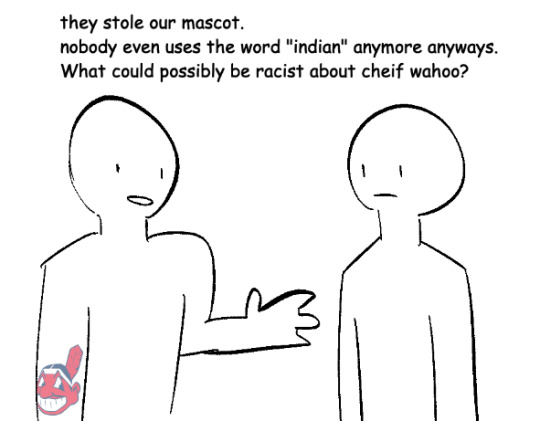


WOW I WONDER WHAT
#got in this conversation recently. admittedly it was my fault. where was the convo gonna go if they had that tattoo#tw racism#racial stereotypes
4 notes
·
View notes
Text
Genuine question from a POC (whose race isn't represented in the Owl House)
I know a lot of people complain about the presence of white characters in the Owl House. They wish Amity was a POC, etc. This is valid, since we have yet to see an interracial couple in the show in which both characters are POC.
I also encourage people who draw those white characters as different races to keep doing so. (Some of that art is so beautiful btw)
But I've thought about it a lot and would those white characters have worked as POC in the show?
I mean there are 3 white families in the Owl House: the Blights, the Clawthornes, and the Wittebanes
Now obviously the Wittebanes have to be white because 1600s British family, Connecticut witch trials, etc.
But I think about racial stereotypes in media, and maybe it's a good thing that the Blights and Clawthornes were not POC?
The Blights:
- Amity's relationship with her parents is extremely toxic
- Her mom is abusive and her dad was negligent.
- She's pressured to get good grades and uphold the family name
- She was a bully for half of the first season.
As for the Clawthornes:
- Eda is a criminal, and not just in a rebel way. She also commits petty theft and scams.
- Gwen's entire character is a dig at anti-vaxxers
- Lilith is always putting pressure on herself and looking for her mother's approval
I don't know, a lot of these sound like racial stereotypes that I have seen criticized a lot in other media.
(Also on a less serious note, if Eda wasn't white, we wouldn't have Wendie Malick voicing her and I honestly think she's perfect as Eda. That voice is iconic.)
Anyway, I guess my question is if any of these characters would have been good POC representation.
#the owl house#toh#poc representation#poc characters#racial stereotypes#amity blight#eda clawthorne#edalyn clawthorne#lilith clawthorne#gwendolyn clawthorne#lumity#odalia blight#alador blight#hunter wittebane#philip wittebane#emperor belos
61 notes
·
View notes
Note
recently i explained why i don't like kirkbride very much to someone and when i talked about the imga they said "that's just how colonized peoples viewed their colonizers". elder scrolls fans are insane
genuinely i dont even know what to say to this one man kirkbride fans are unreal
#this doesnt even make sense as a line of thinking unless im reading it wrong#because the imga are more in line with the view colonizers have of people they're colonizing ?? at least in terms of wildly offensive#racial stereotypes#ask
16 notes
·
View notes
Text
Review: Recitatif
★★★★★ - 5 stars
"My mother danced all night and Roberta's was sick."

Four months in an orphanage together shaped the rest of their lives. Twyla and Roberta were inseparable when they first met. As time moved forward they fell out of touch and grew further apart. However, they find each other in random places at random intervals in their lives - in a restaurant or shopping for groceries. They even find themselves opposing each other's views at a protest. Even though they are in disagreement over every thing each time they meet, they cannot deny the deep bond forged between them and a trauma shared over a memory that neither one of them can perceive in the same way.
First of all, Toni Morrison's writing is absolutely amazing. I am truly grateful for her work's existence in the world - it without a doubt makes it a better place to live in. Recitatif is a short book and easy read, but something that differentiates it from the masses is the way that it's written. A completely beautiful piece of literature, Recitatif is written in an incredibly intelligent way. It makes you feel as though you are living through the characters; their discomfort sets you on edge and their sadness makes you feel waves of negative emotions. Yet, something unique about this book is that one girl is black, the other is white and the reader does not know which one is which.
A social experiment like no other. That is the plain truth of the importance of this book. Books like 1984 by George Orwell and short stories like The Lottery by Shirley Jackson make us uncomfortable by recognising the way in which the world may go. The sad truth about Recitatif is that it faces the way the world already is. It challenges racial stereotypes integrated into our minds. We don't know which of the two girls is black and which is white, yet our minds make assumptions based on the stereotypes Toni Morrison carefully weaved into their characterisations. It hurts to recognise the way our minds perceive the world in this way, however it's very important that we do.
Recitatif is, simply put, one of the best short stories I've ever read. It should be taught in schools. It should be required reading, and that is because it teaches common human decency. Yet, it's a lesson that we don't even realise we need because we are so blind to our own worldview. Recitatif is definitely a wonderful starting place for anyone interested in reading Toni Morrison's catalogue of writing; it's an extremely interesting piece and one you won't forget.
#recitatif#toni morrison#books#book blog#booklr#readblr#book reccs#book recommendations#bookaddict#social experiment#books about racism#racial stereotypes#short story#poc books#black authors#book review#bookworm#book annotations#books and reading
4 notes
·
View notes
Text
At HoochieCon, Black women’s sexual power and agency take center stage
(I did not make this up. This is an article taken from the LA Times

Event creater and curator Zorine Truly dances at the HoochieCon party on Saturday in Glendale. (Jason Armond / Los Angeles Times)
BY MARTINE THOMPSONJUNE 23, 2023 9:53 AM PT
When taking in the images of Black women that adorn the gallery space at HoochieCon, it’s clear the creator and curator, Zorine Truly, 37, has a major soft spot for hoochie mamas — fly Black women who harness the power of their sexuality and creative expression as they see fit. Photos on the walls of the Glendale event space Junior High depict women with artful multilayered updos reaching for the heavens, big smiles sparkling with gold embellishments, vibrant acrylic nails as imaginative as they are long. Nostalgic portraits of friends turning up before the social media boom are spotlighted along with cherished TV and movie characters.
These women may not have an abundance of money, but they draw on their unique flair, swagger and innovation as a tool to show up authentically and claim space in a society that tells them they should shrink. Truly knows these women — often classified as hoochies — have always been more than a punchline in a movie or a mood-board fixture divorced from their humanity. Hoochies flip narrow, misogynoir-fueled ideas of what a good or respectable or fashionable woman can look like and look damn good while doing it. And as Truly explains to The Times, hoochies — in their many iterations over the decades — have long set the blueprint for popular trends and it’s high time they received their flowers.
“Simply put, hoochies are pioneers — for so many different genres of things,” says Truly, a North Memphis, Tenn., native and self-anointed Hoochie Historian who translates her research on hoochie culture into bite-sized videos. Interspersed with glimpses into her personal life and adventures around Los Angeles (like casually cutting up with Janelle Monaé at their Age of Pleasure party), Truly’s posts range from celebrations of prominent women and rituals in hoochie culture and their undeniable impact on fashion, beauty, art and pop culture to thoughtful deep dives that contextualize significant cultural moments, like Brandy and Monica’s ’90s smash hit “The Boy Is Mine.”
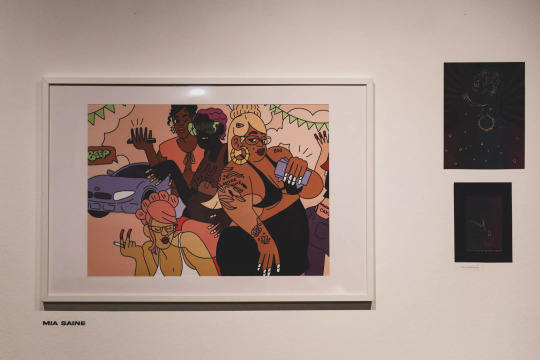
Graphic art on display Saturday at HoochieCon, a gathering celebrating Black style, culture, femme artistry and sexual freedom. (Jason Armond/Los Angeles Times)
The pull to honor this rich legacy in a major way compelled Truly to launch HoochieCon, a group exhibit featuring mixed-media art and music honoring Black women pioneers at the center of hoochie culture. The exhibit, which was co-organized and hosted by the popular queer community space Junior High last weekend, kicked off with three days of activations. The exhibit’s opening day featured the type of moody bisexual lighting that promises a good time. Attendees from near and far came decked with joyful energy and their interpretation of comfortable hoochie attire, and a stripper pole that was added to the gallery for the special day was put to good use thanks to the trio of dancers (Phoenix, Ziyah, Brooklyn) who blessed the space with their skills.
The intention at the heart of HoochieCon resonated with a range of Angelenos on their own journey of discovering and embracing their authentic self and sexual agency, including Earyn McGee, 28. “I am the oldest daughter in a Black family and definitely felt like I had to perform a certain way of being and show up physically a certain way,” she says, noting the baby steps she’s been taking toward less filtered self-expression now that she’s grown. “Even with my outfit for today, I was a little bit nervous but I was just like, ‘I’m trying to be in theme. This was an idea that I had and I’m just gonna go with it.’ I’m trying to do all the things that would’ve made kid-me happy.”
The next two days had a little something for everyone: a panel discussion moderated by Truly, a dance party (more on that shortly) and an outdoor market featuring Black vendors. Chef Rochelle Tyler of Selah Bakery served up vegan cookies with flavors like Hollaback Girl (banana pudding) and Babycakes (strawberry shortcake), while Cake Chemistry offered its boozy miniature red velvet cakes with Hennessy-infused caramel sauce and cream cheese buttercream. There were beanie purses and clothing designs by Beautiful Soul Childz for the avant-garde fashionista who’s gonna serve a look if nothing else, handcrafted jewelry by Skiin & Tones and Studio Ebunoluwa, Hooch Juice travel tumblers by High Standards Cosmetics to help the hoochies hydrate in style, and more.
With music being so deeply intertwined with hoochie culture, Truly knew she had to have space devoted to everybody coming together, dressing up and having fun on the dance floor. The experience of dancing and moving her body to good music in the company of new and old friends makes her feel tapped into a particular feeling of power. “There’s something powerful about dancing despite everything that’s going on outside and despite what’s in the news or maybe what’s happening when you go back to your house,” Truly says. “There’s freedom in getting together in community and seeing Black faces celebrate, regardless of what circumstance they face every day. There’s power, there’s freedom and there’s happiness in it for me.”
DJ Space Age was on music duty for HoochieCon’s dance-floor celebration and did not disappoint. Bangers from the ’90s and early 2000s that stand the test of time boomed through the speakers, eventually teasing out the most committed of wall huggers to let loose and shake a little something.

Dani Daniels poses for a portrait at Hoochie Con.(Jason Armond/Los Angeles Times)
For Danielle Daniels, 29, the visual nods to the ’90s throughout HoochieCon resonated instantly. “My style of dressing is ’90s style so I love the environment of HoochieCon. The bamboo earrings, the jackets, the clothes and the nails — it’s nice to come out and see a lot of girls with the same culture and idea of things and to be able to express ourselves together as Black women,” says Daniels, who considers Halle Berry and Natalie Desselle’s iconic BAPS characters major hoochie inspo for herself and her best friend. “I wanted to come and celebrate ourselves and the beauty that we bring to beauty culture and everything.”

Art on display at HoochieCon.(Jason Armond / Los Angeles Times)
As Truly takes in the fruits of her labor, and the community that has formed around her first HoochieCon, she’s mindful to acknowledge the importance of giving respect and reverence to women who have pioneered and “touched popular culture for so long” without reaping the benefits or even receiving credit. “Not only did they pioneer it, they also had to suffer for it,” Truly says. “They had to suffer to wear their hair the way they wanted to. They had to suffer to wear their nails the way they wanted to, and gold teeth, and to be sexually liberated. They had to suffer to shine.”
One day, years later, people will look at images of Truly’s HoochieCon celebration. “What do you hope they take away?” I ask the Hoochie Historian.
“I hope they take away from HoochieCon the importance of being yourself, no matter what people might judge you by,” says Truly, releasing a deep exhale, eyes watering as she processes the idea of HoochieCon reaching people generations into the future. “It’s important to be happy with how you look, how you feel, how you dress, and the choices that you make, and that is the most important thing. I want people, especially Black women, to take away that they can be fully themselves no matter what that looks like and still be worthy of all the good things.”
#Racial Stereotypes#Self-Sexual Exploitation#Negative Imagery#Self-Degradation#Feminist Lies#Women Objectifying Themselves#Women As Sex Objects#Double-Standards#Gender Double-Standards#Dumb Bitch Logic
3 notes
·
View notes
Text

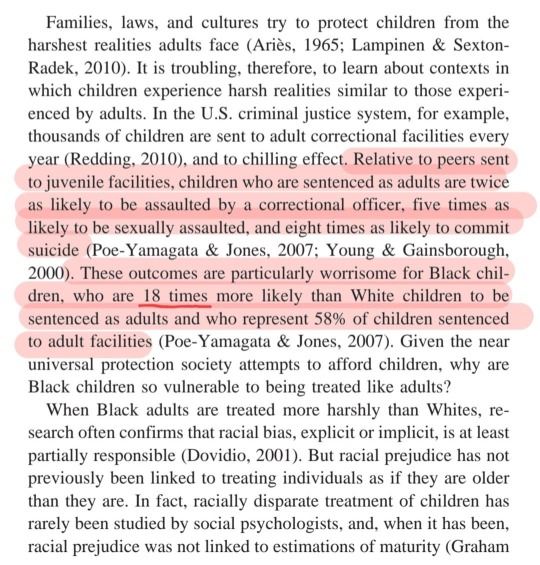

(source)

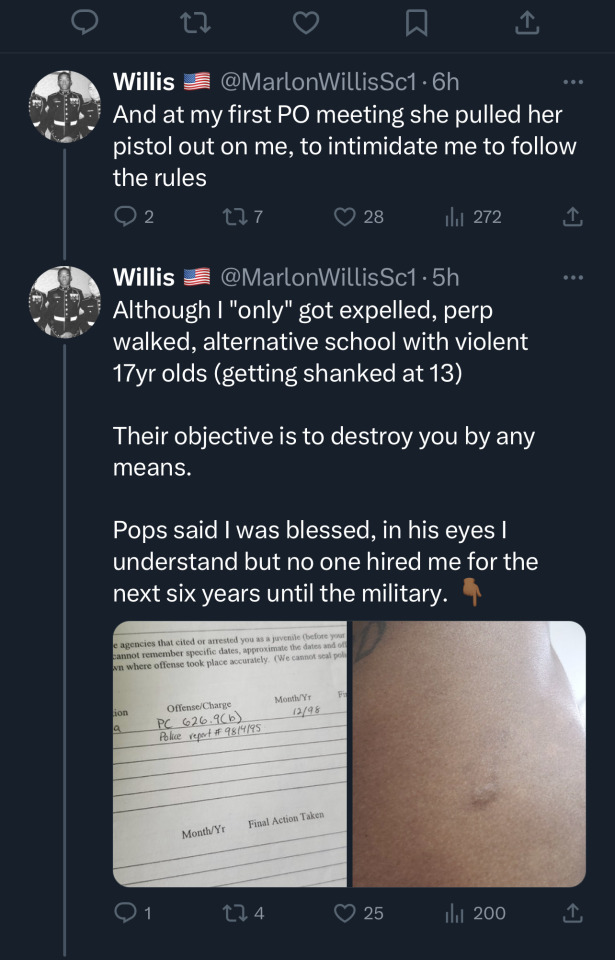
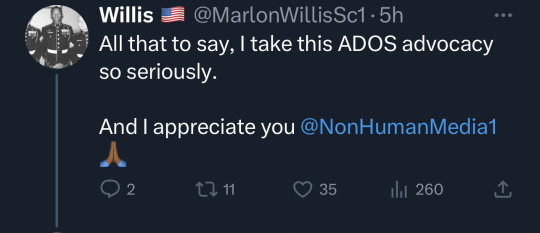
The American criminal “justice” system is deeply racist. From the police, to the jury system, to the prison system.
Mass incarceration laws and the death penalty all target Black and Brown people disproportionately. Politicians who brand themselves as “law-and-order” candidates, or as no nonsense, “tough-on-crime” politicians are fully aware of these structurally racist underpinnings of the U.S. criminal system, and they gladly use law & order as a kind of racist dog whistle: when the question is, “Who are we going to lock up?”the unspoken but understood answer is, “BLACK people!” Especially in, but not limited to, the “former” slave states (aka current Republican states.).
This kind of dog whistle politics (aka “Southern Strategy”) to appeal to conservative white southern voters is not new.
The same is true with how we treat people with drug addictions. America has two completely different views on who is deserving of compassion and who needed to be locked away in prison forever.
And if you’re reading this from a European country, please don’t make the mistake of thinking that your country is somehow different or better. HA! America is a racist country and(!) Europe is every bit as racist against Black and Brown people as anywhere else.
Universally, there is a correlation between who gets the best jobs & housing and skin color; or who gets jailed more and their skin color. These cannot be explained away without acknowledging racism.
Colorism and anti-Blackness are worldwide.
#politics#racism#mass incarceration#two americas#criminalizing blackness#racial stereotypes#southern strategy#dog whistle politics
138 notes
·
View notes
Text
believe me when i say i really support poc as the protagonists in television! but chop socky chooks is one of the exceptions! BECAUSE THE SHOW PROMOTES RACIAL STEREOTYPES!!! TWO OF THE MAIN CHARACTERS, CHICK P (THE WOMAN) AND CHUCKIE CHAN (THE GLASSES GUY) ARE WALKING CHINESE STEREOTYPES, WHEREAS K.O. JOE (THE BIG GUY WITH AN AFRO) IS LITERALLY A BLACK STEREOTYPE!!! THIS RACISM IS UNACCEPTABLE!!! I SUPPOSE 2008 WAS A DIFFERENT TIME!!! BUT NOW WE HAVE BECOME MORE EDUCATED AND WOKE AS A SOCIETY!!! THE ONLY GOOD THING I CAN SAY ABOUT THE SHOW IS THAT IT DIDN'T EVEN MAKE IT TO A YEAR, AND I HOPE TV CHANNELS ARE NO LONGER AIRING THIS RACIST SHOW!!!
#tw racism#chop socky chooks#anti chop socky chooks#racism#racial stereotypes#anti racist#blm#black lives matter#stop asian hate#stop aapi hate#blm ally#satire
4 notes
·
View notes
Photo
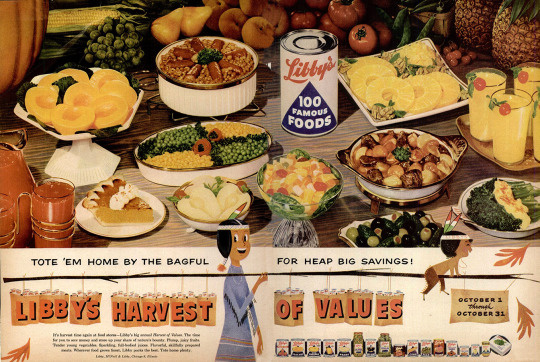
Libby’s, 1958
21 notes
·
View notes
Text
A Post About Racial Stereotypes
There has been a lot of great meta for Our Flag Means Death with regard to how Ed struggles to be seen as more than the “violent man of color” stereotype. This is a post about how that stereotype originated historically. It’s seriously going to be rough, so I’m putting the rest below a cut.
This is a stereotype that originated a few of different times for a few of different demographics. Unfortunately, I am not educated on how this applies to Maori men specifically, which is what would be most applicable to Ed. If anyone has information there, I welcome the addition. Nevertheless, I think this post can still be educational. When it comes to racial stereotypes, there’s a lot of repetition.
Alright, for indigenous people in the Caribbean, that goes back to the Spanish Empire. Spanish conquistadors weren’t allowed to enslave people they encountered...unless they were cannibals. Which is to say, unless the conquistadors said they were cannibals. This is where the stereotype of the cannibalistic Caribbean person originated. It is, in fact, where the word “Caribbean” originated.
Then you have the stereotype of the ‘angry Black man’, which originated in the United States post-Civil War. Before the Civil War, the stereotype for Black people was that they were “childlike” and “needed” slavery. If that seems less like a well-reasoned argument and more like an ad hoc justification for slavery (which was very profitable) yeah, that’s because it was.
But after the Civil War, only those convicted of a crime could be enslaved. This incentivized the development of the “angry Black man” stereotype, which was used to justify Jim Crow laws that could be used to re-enslave those liberated by the 13th Amendment.
The modern version of this, by the way, is fear-mongering about “gang warfare” and “rising crime levels”, which are used to justify increased police presence so that more Black people can be enslaved via the legal system.
In conclusion, this is historical context of the various “violent man of color” stereotypes. For more information, I recommend the Jim Crow Museum website: https://www.ferris.edu/HTMLS/news/jimcrow/index.htm (In case it wasn’t obvious, it’s a museum documenting historical racism. It’s highly educational, but also really hard to stomach.) I hope this post was helpful to anyone not familiar with the history there.
#our flag means death#edward teach#blackbeard#meta#racism //#racial stereotypes#discussion of racism and racial stereotypes#slavery#slavery //
2 notes
·
View notes
Text
Is AI Perpetuating Racial Stereotypes or Way Too Woke? - Back in Black |...
youtube
Back in Black does AI
0 notes